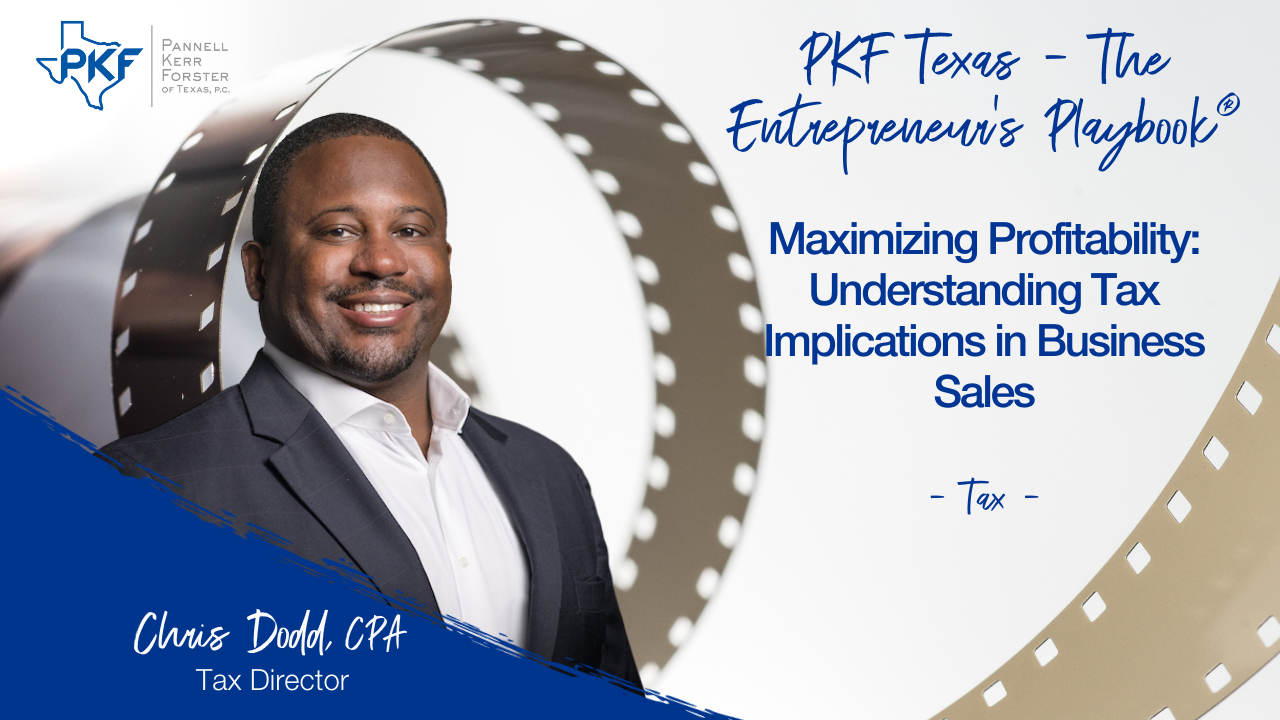Maximizing Profitability: Understanding Tax Implications in Business Sales

Chris Dodd, CPA, Tax Director, joins Jen Lemanski to unravel the complexities of tax implications of the sale of a business. They explore the differences between selling C Corp stocks and assets, and the unique considerations for selling partnership interests or assets. Learn about Section 1202 exclusions and qualified small business stock exclusions, providing potential avenues for maximizing gains. If you’re contemplating a business sale, gain valuable insight into the analysis needed from the formation to the selling stage.
Jen: This is the PKF Texas Entrepreneur’s Playbook, I’m Jen Lemanski, and I’m back with Chris Dodd, one of our tax directors and one of our Approachable Advisors® here at PKF Texas. Chris, welcome back to the Playbook.
Chris: Thanks for having me, Jen.
Jen: You know, we talked a little bit about transactions the last time you were here, and so when a company’s buying or forming a new entity, what types of things should they consider?
Chris: So, I like to think about it in multiple ways. First thing is being flexible. C Corps not really flexible. If you own 10% of the C Corp, you get 10% of any of the distributions that come out. Differences in a partnership, it’s a lot more flexible. For instance, let’s say you get an investor that comes in, he’s the cash guy. He says, look, I like you, but I want 2x my return before you start participating, that’s great in a partnership sense because that’s an economic arrangement you can follow. So, he gets two times his initial investment back before you start participating along with him, which makes it very flexible in a lot of these new deals because, as we know, cash is king.
Second, you got to look at the tax rates. Under current tax, corporations are taxed at 21% it’s down from the high of 35%. However, with partnerships the income gets allocated to the individuals in proportion to their interest. So, if you own 10%, you’re going to get 10%, but you’re going to be taxed on, let’s say a personal level of 37%. So, it’s going to be taxed at the partner’s amount, or the partner’s rate. So, since it’s taxed at 37%, yeah, you’re going to say it’s a little higher than the C Corp. However, you also get what’s called the qualified business income deduction, which is up to 20% of the taxable income from that partnership. So, usually the effective rate, let’s say for an individual using a 37% rate is around 29%.
Jen: Okay. So, a little bit better there.
Chris: Yeah, a little bit better. But then now we start looking at distributions. Because C corps, they’re going to be taxed twice. You’ll hear the term double taxation a lot whereby the corporation pays their tax 21%. And then once they distribute that income in the form of a dividend, that gets taxed again. So, now you got tax at 20%, and let’s say the individuals at the highest tax rate, they’re going to be taxed another 20% for whatever dividend that they receive. So, double taxation. Partnership though, when they get a distribution any distributions up to their basis are tax free. Okay. They’ve already paid tax on it. So, once that income’s flowed through and now they get the actual cash, it comes out tax free, again, up to your basis.
Lastly, the sale, we’re talking about a sales process that’s a little bit different. So, C Corps, you can go either tax on the actual corporate stock or you can go taxed on the corporate assets. So, a lot of people like to do tax on that corporate stock because it’s tax at the capital gains rates, 20% being the highest rate. So, it makes it a lot easier. However, sometimes you may not be able to get someone to actually buy the corporate stock because they may want to step up and base this and they want to buy the corporate assets. So, there’s a lot of negotiation there. Now, when you’re selling partnership interest, whether you sell the partnership interest itself or you sell the partnership assets, it’s still for tax purposes going to be a sale of assets. So, you got to keep that in mind. Now, one thing to note when you talk about corporations is you may have what’s called a section 1202 exclusion or a qualified small business stock exclusion whereby based on current rates you may be able to exclude 100% of the gain. So, when you’re talking about selling the corporation or the partnership, there’s a lot of analysis to be done upfront from the formation side of it, and then from the sell side of it.
Jen: So, at what point should they bring you in if they’re like looking to sell to kind of do some modeling? Is that something that we’ll do and help clients out with?
Chris: Yes. When you’re either going to form the company or you form a company to buy another company or you’re looking at what type of company to buy during the negotiation whether you want, if it’s in a current state, let’s say it’s in a C Corp and you want it to be in a partnership how to get it there, it’s best to bring your advisors in on the front so you can model every single possible transaction there is and gives you the most information possible.
Jen: Perfect. Well, it sounds like we’ve got somewhere to talk about in future videos. Sound good?
Chris: Yes, we do.
Jen: Perfect. This has been another Thought Leader production, brought to you by PKF – Texas the Entrepreneur’s Playbook. For more information about this and other topics, visit pkftexas.com/insights. Tune in next week for another chapter.

